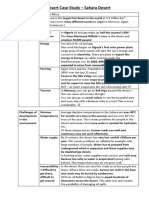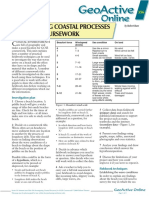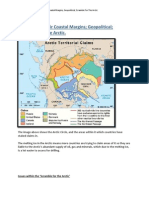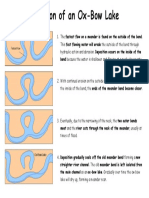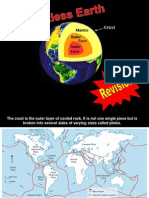Case Study Holderness Coastline
Case Study Holderness Coastline
Uploaded by
biology111Copyright:
Available Formats
Case Study Holderness Coastline
Case Study Holderness Coastline
Uploaded by
biology111Copyright
Available Formats
Share this document
Did you find this document useful?
Is this content inappropriate?
Copyright:
Available Formats
Case Study Holderness Coastline
Case Study Holderness Coastline
Uploaded by
biology111Copyright:
Available Formats
Case study on coastal erosion: The Holderness Coastline (Mappleton)
What is the Holderness Coast? The Holderness Coast, East Yorkshire, is one of Europe's
fastest eroding coastlines; in fact the average
annual rate of erosion is around 2 metres per
year!
What are the causes of this? The coast is
frequently attacked by powerful destructive
waves driven by strong winds blowing
across the North Sea.
• The soft boulder clay cliffs, left after the last
Ice Age, are easily eroded.
• The waves erode the base of the cliff by
hydraulic action and abrasion. The destructive
power of the waves may be increasing due to
slow sea level rise.
What are the effects of this? A 4km strip of
land lost since Roman times and many villages have disappeared.
• The North Sea gas terminal at Easington is one of the two eat coast sites where gas
pipelines from the North Sea drilling platforms come ashore. It is a vital part of the UK’s
energy supply infrastructure, but it is under threat because of its cliff-top location.
• Coastal towns such as Withernsea and Hornsea, farms, roads and tourist facilities such as
caravan sites are under threat from the advancing sea.
Is there anything being done about this?
Yes, there are several coastal defences in place to try and reduce the force of the waves on
the cliff bases. These include:
Groynes (low walls built out into sea, usually at right angles to the coastline, help to break
power of incoming waves, slow down process of longshore drift.
Rock wall (stop waves removing sand and gravel from beach)
Embankments (high walls are situated where beach meets the land/cliff, usually made of
concrete/stone and bounce back storm waves)
Sand and shingle dumping (material dumped offshore to reduce power and height of
incoming waves).
What about Mappleton?
Mappleton is a village and it is situated on the North Sea coastline in an area known as
Holderness.
• Sea defences at Mappleton-caused erosion 6 times faster in the area to the South of
the village than 10 years ago.
• Beaches are very narrow (so are not good defences against coastal erosion-only
WIDE beaches are).
• In 2001, it was found that there were about 249 people living in Mappleton and
coastal defences are expensive, so councils can only pay for them in areas where
quite a few people live.
You might also like
- Edexcel Alevel Geography - Regeneration Revision NotesDocument23 pagesEdexcel Alevel Geography - Regeneration Revision NotesannabelkhewittNo ratings yet
- Flooding in YorkDocument24 pagesFlooding in Yorksuejacksonthree100% (26)
- Hjulstrom Curve Worksheet 2012Document3 pagesHjulstrom Curve Worksheet 2012Catherine MakNo ratings yet
- IB Geography Oceans Case StudiesDocument6 pagesIB Geography Oceans Case StudiesMarc Wierzbitzki0% (1)
- Earthquake Case Studies in A Ledc MedcDocument16 pagesEarthquake Case Studies in A Ledc Medcapi-301535260No ratings yet
- Geofile Stage 5Document4 pagesGeofile Stage 5reservoirgeogsNo ratings yet
- Globalisation RevisionDocument21 pagesGlobalisation Revisionapi-407286530No ratings yet
- Hot Desert Case Study - Sahara DesertDocument1 pageHot Desert Case Study - Sahara DesertCamilleNo ratings yet
- Forest Microclim GeofileDocument4 pagesForest Microclim GeofileGuy LeafNo ratings yet
- A Level Geography GlossaryDocument17 pagesA Level Geography Glossarysteve119No ratings yet
- A Level Geography Coasts RevisionDocument11 pagesA Level Geography Coasts RevisionWill Birchall100% (1)
- Energy RevisionDocument28 pagesEnergy Revisionapi-407286530100% (2)
- Geofile Exam Techniques AsDocument4 pagesGeofile Exam Techniques AsreservoirgeogsNo ratings yet
- Global Hazards Edexcel AS RevisionDocument38 pagesGlobal Hazards Edexcel AS Revisionjoblack91% (11)
- Regenerating Places RevisionDocument19 pagesRegenerating Places Revisionapi-407286530No ratings yet
- 13 14 Hard Vs Soft Card Sort CompleteDocument1 page13 14 Hard Vs Soft Card Sort Completeapi-336814146No ratings yet
- Coastal FieldworkDocument4 pagesCoastal FieldworkebidNo ratings yet
- Physical Geography Case Study RevisionDocument17 pagesPhysical Geography Case Study Revisionapi-336814146No ratings yet
- Coasts Key Word Glossary (1) MDocument5 pagesCoasts Key Word Glossary (1) MRia PatelNo ratings yet
- GEOACTIVE - Large Scale River Basin MGMT ColoradoDocument4 pagesGEOACTIVE - Large Scale River Basin MGMT ColoradoThaddeus NgNo ratings yet
- Edexcel As Geography - Global ChallengesDocument82 pagesEdexcel As Geography - Global ChallengesharryroundNo ratings yet
- IB Geography, Oceans and Their Coastal Margins, Geopolitical, Scramble For The ArcticDocument3 pagesIB Geography, Oceans and Their Coastal Margins, Geopolitical, Scramble For The ArcticHolly OliviaNo ratings yet
- India: A Case Study of A Newly Industrialising Country: OnlineDocument4 pagesIndia: A Case Study of A Newly Industrialising Country: OnlinedaibawdenNo ratings yet
- Geofile Contrasting Contemporary Case StudiesDocument4 pagesGeofile Contrasting Contemporary Case StudiesreservoirgeogsNo ratings yet
- Geofile Rural IssuesDocument4 pagesGeofile Rural IssuesreservoirgeogsNo ratings yet
- Ox-Bow Lake Handout 1Document1 pageOx-Bow Lake Handout 1api-336814146No ratings yet
- Hydrology & Fluvial GeomorphologyDocument13 pagesHydrology & Fluvial Geomorphologylyana1234100% (2)
- GF550Document4 pagesGF550djthomas18No ratings yet
- Geography A2 LevelDocument1 pageGeography A2 Levelapi-25965024No ratings yet
- l7 - Case Study On The River TeesDocument8 pagesl7 - Case Study On The River Teesapi-258813608No ratings yet
- IgcsecoastsrevisionDocument18 pagesIgcsecoastsrevisionapi-232441790100% (2)
- GA376 Managed Coastal Retreat North Norfolk Coast - Apr 2007 Series 18 Issue 3Document4 pagesGA376 Managed Coastal Retreat North Norfolk Coast - Apr 2007 Series 18 Issue 3geoboom12No ratings yet
- Hydrology ASDocument20 pagesHydrology ASlourene liebenbergNo ratings yet
- GCE A LEVEL H2 GEOGRAPHY 9730 Physical Geography Lithospheric NotesDocument24 pagesGCE A LEVEL H2 GEOGRAPHY 9730 Physical Geography Lithospheric NotesWong Rong JunNo ratings yet
- BoscastleDocument4 pagesBoscastleapi-310353155No ratings yet
- IGCSE Geography Course Notes: TectonicsDocument42 pagesIGCSE Geography Course Notes: TectonicsxerxesNo ratings yet
- The 3 Gorges DamDocument4 pagesThe 3 Gorges Damapi-361310234No ratings yet
- Geofile China and IndiaDocument4 pagesGeofile China and IndiareservoirgeogsNo ratings yet
- HN Wong & K Ho - Landslide Risk Management and Slope Engineering in HKDocument40 pagesHN Wong & K Ho - Landslide Risk Management and Slope Engineering in HKcheewingyuenNo ratings yet
- Aging Populations - ConsequencesDocument4 pagesAging Populations - Consequencesreservoirgeogs100% (2)
- The Restless EarthDocument164 pagesThe Restless Earthb_osborneNo ratings yet
- A 2 Unit 3 Geography Revision Guide EdexcelDocument90 pagesA 2 Unit 3 Geography Revision Guide EdexcelRebecca100% (2)
- Theme 1 - Case Study BookletDocument21 pagesTheme 1 - Case Study BookletWarlinghamGeog100% (3)
- Drawing Population PyramidsDocument6 pagesDrawing Population PyramidsreservoirgeogsNo ratings yet
- India MonsoonDocument4 pagesIndia MonsoonDannySP10No ratings yet
- Paper 4 - Alternative To Coursework - The Geography Study SchoolDocument7 pagesPaper 4 - Alternative To Coursework - The Geography Study SchoolTanatswa Ticharwa100% (1)
- Chapter - 16 Coast and Coral ReefsDocument50 pagesChapter - 16 Coast and Coral ReefsgopeNo ratings yet
- Going Global AS Geography NotesDocument35 pagesGoing Global AS Geography NotescelesteabrahamsNo ratings yet
- HYDROLOGY AND FLUVIAL GEOMORPHOLOGY - 3rd edition - 副本Document48 pagesHYDROLOGY AND FLUVIAL GEOMORPHOLOGY - 3rd edition - 副本Claire DingNo ratings yet
- Geo IGCSEDocument3 pagesGeo IGCSEZeynep Akı100% (1)
- Energy and EquilibriaDocument24 pagesEnergy and EquilibriaRAGINI RAMACHANDRANNo ratings yet
- IB Geography Generic Essay RubricDocument4 pagesIB Geography Generic Essay Rubricgabr0088No ratings yet
- Drainage BasinsDocument4 pagesDrainage BasinsDannySP10100% (1)
- GCSE Rivers River Landforms FormationDocument48 pagesGCSE Rivers River Landforms FormationWill TeeceNo ratings yet
- Overpopulation Underpopulation and Optimum PopulationDocument13 pagesOverpopulation Underpopulation and Optimum Populationapi-230294264100% (2)
- Most Dangerous Deserts In The World | Deserts Of The World for Kids | Children's Explore the World BooksFrom EverandMost Dangerous Deserts In The World | Deserts Of The World for Kids | Children's Explore the World BooksNo ratings yet
- Holderness SMHWDocument14 pagesHolderness SMHWpoopNo ratings yet
- Sustainable Management of Holderness CoastDocument20 pagesSustainable Management of Holderness CoastRecordingNo ratings yet
- Holderness Case StudyDocument2 pagesHolderness Case Studymrstone77No ratings yet
- Causes of TsunamiDocument2 pagesCauses of TsunamiAnanth SrinivasanNo ratings yet
- Class 1Document27 pagesClass 1KALYAMPUDI MANOHARNo ratings yet
- Coral ReefDocument2 pagesCoral Reefyahia222000No ratings yet
- Gyres and EddiesDocument14 pagesGyres and Eddiesjikku joyNo ratings yet
- Assignment 5 Geo 334Document13 pagesAssignment 5 Geo 334imaadNo ratings yet
- Pilot Books IndexDocument2 pagesPilot Books IndexBocai EugenNo ratings yet
- Marine EcosystemDocument39 pagesMarine EcosystemEdvie Mae BaralNo ratings yet
- PDFDocument2 pagesPDFAckmed PharixNo ratings yet
- Meteo Module 9Document44 pagesMeteo Module 9carlgavinsletartigasNo ratings yet
- Tsunami Warning SystemDocument27 pagesTsunami Warning Systemd_melanaNo ratings yet
- Continental Margins Lab KeyDocument2 pagesContinental Margins Lab KeyBarry SeeboNo ratings yet
- Earth Science m10 ND m13Document8 pagesEarth Science m10 ND m13jovelyn bolingetNo ratings yet
- Tsunami (Physics Assignment)Document25 pagesTsunami (Physics Assignment)huiyuNo ratings yet
- Pdf&rendition 1Document4 pagesPdf&rendition 1Piank crazyNo ratings yet
- Oceans - Simon, SeymourDocument44 pagesOceans - Simon, SeymourCatalina De AngellaNo ratings yet
- Maritime Delimitation in The Black Sea Romania v. UkraineDocument7 pagesMaritime Delimitation in The Black Sea Romania v. UkraineMargreth MontejoNo ratings yet
- 1979 The Evolution of Pescadero MarshDocument180 pages1979 The Evolution of Pescadero MarshMartha LetchingerNo ratings yet
- Nav TideDocument16 pagesNav TideShoaib hossainNo ratings yet
- Coastal Erosion Dissertation IdeasDocument6 pagesCoastal Erosion Dissertation IdeasPaySomeoneToDoMyPaperNewark100% (2)
- Types of Coastal StructuresDocument18 pagesTypes of Coastal StructuresMourad Nadeer100% (1)
- Haryana - Geography Lecture: 9 Oceanography: Water (Oceans)Document15 pagesHaryana - Geography Lecture: 9 Oceanography: Water (Oceans)shagunNo ratings yet
- Internal Water (Perairan Pedalaman)Document13 pagesInternal Water (Perairan Pedalaman)Ratna HidayatiNo ratings yet
- WCS Lecture 7Document30 pagesWCS Lecture 7Md. Muhaiminul IslamNo ratings yet
- Earth Science For STEM: Quarter 2 - Module 7: Structure and Evolution of Ocean BasinsDocument9 pagesEarth Science For STEM: Quarter 2 - Module 7: Structure and Evolution of Ocean BasinsCheena Francesca Luciano100% (1)
- Report - ICGS ThondiDocument9 pagesReport - ICGS ThondiBhuvana EswariNo ratings yet
- Example Ref List HarvardDocument1 pageExample Ref List HarvardNguyen Quynh AnhNo ratings yet
- Geoindicadoes (BUSH, 1999)Document24 pagesGeoindicadoes (BUSH, 1999)Luan MartinsNo ratings yet
- Gabu by Carlos AngelesDocument3 pagesGabu by Carlos AngelesDaine SalazarNo ratings yet
- W1 Water On EarthDocument28 pagesW1 Water On EarthNetkoNo ratings yet
- Waves, Beaches & CoastsDocument40 pagesWaves, Beaches & CoastsKaran SinghNo ratings yet







